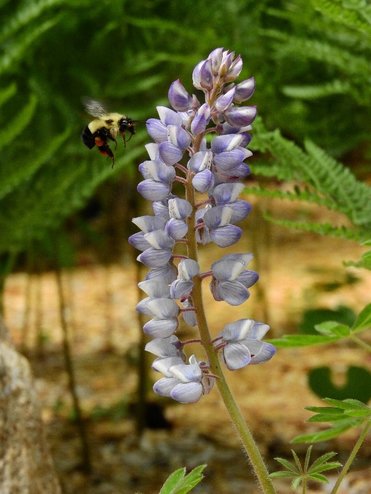 Bumblebee and lupine Bumblebee and lupine Break out the honey cakes and raise a glass of mead—it's National Pollinator Week! You probably won't find the observance pre-printed on your wall calendar, but it's worth penciling in as a reminder to honor those buzzing, fluttering, hovering creatures whose efforts are essential to so many plants we prize. I learned about this celebration of pollination from an item in the summer issue of Michigan Nature, the magazine of Michigan Nature Association. From there I went on to find out more from Pollinator Partnership, a group devoted to promoting the health of pollinators through conservation, education and research. 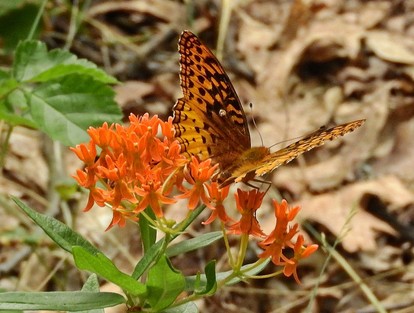 Milkweed visitor Milkweed visitor Bees and butterflies usually come to mind when we think of critters that flit from flower to flower, sipping nectar and distributing pollen in the process. Those are important pollinators, for sure, but birds, bats, beetles and other animals also do the job. 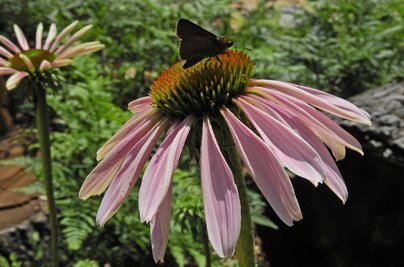 Moment of repose Moment of repose And a vital job it is. Globally, some 1,000 plants grown for food and drink, fiber and pharmaceuticals depend on animal pollination for successful fruit and seed production. If you fancy chocolate, coffee or blueberries, if you have a passion for pumpkins, potatoes or peaches, if you're an apple or almond aficionado, if you treasure the tequila in your Margarita, praise pollinators! 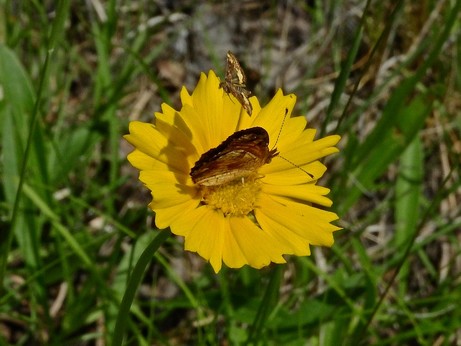 Sharing the wealth Sharing the wealth But pollinators need more than praise. They need protection. In many parts of the world, including this country, pollinating animals are suffering the effects of diseases, parasites, harmful chemicals, habitat loss and invasive plant and animal species. How can you help? 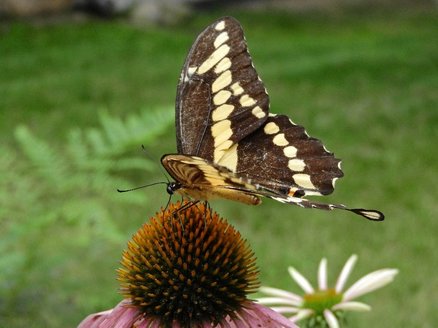 Swallowtail on coneflower Swallowtail on coneflower One of the biggest ways is by making your piece of the Earth—whether pocket garden or multi-acre spread—pollinator-friendly. Reduce pesticide use, install bee and bat houses, and cultivate native plants that attract pollinators and provide nectar and larval food. (You can find a guide to appropriate plants for your area by entering your zip code here.) 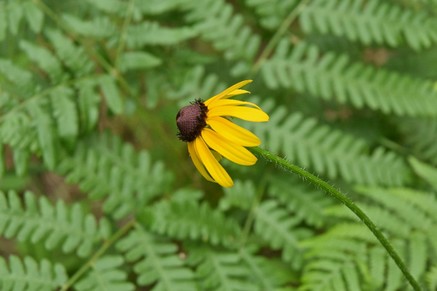 Black-eyed susan Black-eyed susan For several years, I've been buying native plants from our local conservation district's annual sale and encouraging the native species already growing on our property by saving and scattering their seeds and clearing away invasives that would choke them out. The lupine, coneflowers, columbine, prairie smoke, bee balm and black-eyed susans have rewarded me with floral displays and the entertaining antics of their winged visitors. I'm hopeful the milkweeds and blazing stars are mature enough to bloom this year. I'll be sure to share the results when they do. And once my broken foot is healed and I'm more mobile, I hope to take you on a tour of my friend Sandy's flourishing native plant garden—a delight for pollinators and people alike. Learn more about pollinators by visiting Pollinator Partnership's Learning Center. For more about native plants and native landscapes, connect with the national, not-for-profit organization Wild Ones. Useful books on native plants and their role in sustaining wildlife: Bringing Nature Home, by Douglas W. Tallamy (Timber Press, 2007) The Natural Habitat Garden, by Ken Druse, with Margaret Roach (Clarkson Potter, 1994; paperback Timber Press, 2004) All photos by Nan Sanders Pokerwinski
15 Comments
Cindi
6/21/2017 07:01:43 am
Sadly, we have fewer bees each year. We do use a natural, "bee safe" pesticide on our plants.
Reply
Nan
6/21/2017 07:28:41 am
That is sad. Do you get many butterflies?
Reply
Cindi
6/21/2017 08:13:13 pm
We do have quite a few butterflies, especially since we are on the migration route of the Monarchs, whose numbers are sadly declining, too. 6/21/2017 08:25:29 am
Interestingly enough, I'm seeing MORE pollinators this year. Maybe it's due in part to our meadow maturing, but there do seem to be more of the little buzzing fliers around here. And I see a lot more milkweed along the roadsides, which bodes well for those beautiful Monarchs. I think we may be turning a corner.
Reply
Nan
6/21/2017 08:32:34 am
That's encouraging to hear! I understand the monarchs still need lots of the less-common orange milkweed, too. I see a little of that in our neighborhood, and I'm planting more.
Reply
6/21/2017 09:39:56 am
Oh, I just love this post, Nan. I often wondered what special plants would attract our winged beauties and be beneficial as well, but never took the time to research. Living on 50 acres we have many wild flowers in the fields that attract, but nothing “planted” I can watch out my window while doing dishes or writing. This sounds like a lovely project.
Reply
Nan
6/22/2017 06:43:53 am
Sounds like a lovely view, Susan!
Reply
Nan
6/22/2017 06:44:58 am
Thanks, Colleen. I'm on the mend and meanwhile enjoying watching the birds, bees and butterflies.
Reply
Katherine Myers
6/21/2017 06:48:34 pm
With six bee hives on Lily Hill, we are very careful about chemical use. Bees used to visit the fountain for a drink, but now that the beekeeper has moved them nearer to the pond, we don't see them as often. Looking forward to some very local honey!
Reply
Nan
6/22/2017 06:46:33 am
Sweet!
Reply
Sue Schneider
6/22/2017 04:27:19 am
Another terrific post. We have more milkweed on our "wild" hill this year, I'm happy to report. I'm always glad to see the bees in the vegetable and flower gardens.
Reply
Nan
6/22/2017 06:48:14 am
Glad to hear you're enjoying your winged visitors, Sue!
Reply
Sally C Kane
6/22/2017 05:54:53 am
How perfectly timely, this topic, and so informative. I took a Solstice early evening walk the other night, and marveled at the abundance of milkweed, thistle, daisies, and mullien, unconsciously looking for those pollinators. It may have been close to their bedtime, becasue I'm encouraged by the increase in milkweed, but didn't know that Monarchs need the orange variety more. Loved the close up photos, especially the purple bee balm, Monarda. Thanks for raising our consciousness.
Reply
Nan
6/22/2017 06:50:48 am
I learned about the need for the orange milkweed from the native plant/native landscape expert who gives a free workshop every year before the conservation district sale. He also recommended one of the books I listed.
Reply
Leave a Reply. |
Written from the heart,
from the heart of the woods Read the introduction to HeartWood here.
Available now!Author
Nan Sanders Pokerwinski, a former journalist, writes memoir and personal essays, makes collages and likes to play outside. She lives in West Michigan with her husband, Ray. Archives
April 2022
Categories
All
|
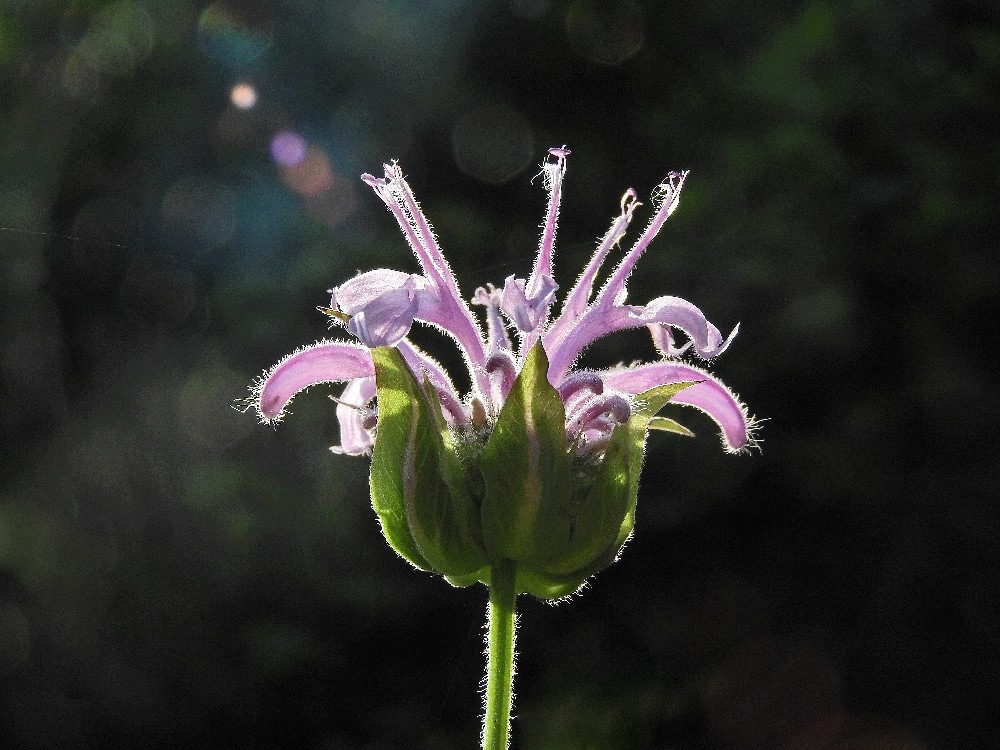
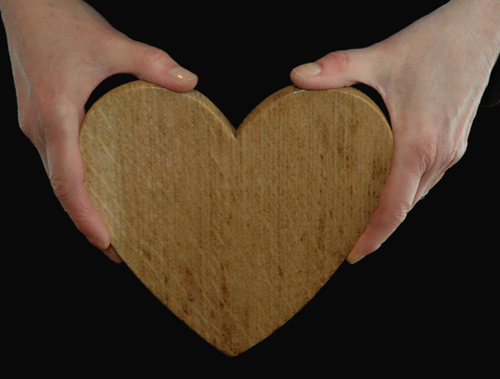
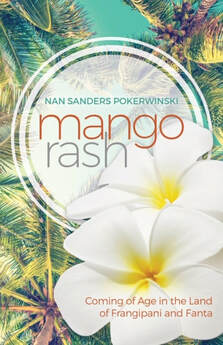
 RSS Feed
RSS Feed